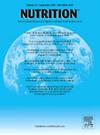Calf circumference is a useful muscle mass marker for predicting length of stay and mortality: A secondary analysis of a cohort study in hospitalized individuals
IF 3.2
3区 医学
Q2 NUTRITION & DIETETICS
引用次数: 0
Abstract
Objective
To evaluate the accuracy of calf circumference (CC) and determine its association with clinical outcomes of hospitalized patients.
Methods
This is a secondary analysis of a prospective cohort study of inpatient. CC values were adjusted by body mass index (BMI) to remove adiposity’s confounding effects: the measured value decreased by 3 cm (BMI 25–29.9 kg/m²) or 7 cm (BMI 30–40 kg/m²), and the cohort point for CC, indicating muscle mass loss, was ≤33 cm for women and ≤34 cm for men. Clinical outcomes include length of stay (LOS) and in-hospital mortality.
Results
Overall, 453 patients (59 [46–68] years, 51.4% men, and 67.8% admitted to surgery) were evaluated. The median LOS was 5 days (interquartile range, 3–8 days), with 52.1% of patients hospitalized for 5 days or longer, and in-hospital mortality observed in 5.1% of patients. About 33.1% and 42.4% of all patients had CC, crude and adjusted by BMI, respectively. Low CC (crude) showed the best accuracy (area under the curve = 0.72) to predict in‐hospital mortality. In logistic regression models, it was observed that patients with low CC (crude and BMI-adjusted) were more likely to have poorer outcomes compared to patients with normal CC: LOS ≥5 days (odds ratio = 1.7; 95% confidence interval 1.2–2.5) and in-hospital mortality (odds ratio = 4.1; 95% confidence interval 1.3–13.0).
Conclusions
Reduced CC values are associated with prolonged LOS and mortality. Considering its clinical applicability, measurement of CC should be introduced in the nutrition assessment of hospitalized individuals.
小腿围是预测住院时间和死亡率的有用肌肉质量指标:一项住院个体队列研究的二次分析
目的评价小腿围度(CC)的准确性,探讨其与住院患者临床预后的关系。方法:对住院患者的前瞻性队列研究进行二次分析。通过体重指数(BMI)调整CC值以消除肥胖的混杂效应:测量值下降了3 cm (BMI 25-29.9 kg/m²)或7 cm (BMI 30-40 kg/m²),CC的队列点(表明肌肉质量损失)女性≤33 cm,男性≤34 cm。临床结果包括住院时间(LOS)和住院死亡率。结果共评估453例患者(59[46-68]岁,男性51.4%,手术住院67.8%)。中位生存期为5天(四分位数间距为3-8天),52.1%的患者住院5天或更长时间,5.1%的患者住院死亡率。约33.1%和42.4%的患者分别为粗CC和BMI调整CC。低CC(粗)在预测院内死亡率方面显示出最好的准确性(曲线下面积= 0.72)。在logistic回归模型中,观察到低CC患者(粗CC和bmi调整后)与正常CC患者相比更有可能出现较差的结局:LOS≥5天(优势比= 1.7;95%可信区间1.2-2.5)和住院死亡率(优势比= 4.1;95%置信区间1.3-13.0)。结论CC值降低与LOS延长和死亡率相关。考虑到CC的临床适用性,应将其纳入住院患者的营养评估中。
本文章由计算机程序翻译,如有差异,请以英文原文为准。
求助全文
约1分钟内获得全文
求助全文
来源期刊

Nutrition
医学-营养学
CiteScore
7.80
自引率
2.30%
发文量
300
审稿时长
60 days
期刊介绍:
Nutrition has an open access mirror journal Nutrition: X, sharing the same aims and scope, editorial team, submission system and rigorous peer review.
Founded by Michael M. Meguid in the early 1980''s, Nutrition presents advances in nutrition research and science, informs its readers on new and advancing technologies and data in clinical nutrition practice, encourages the application of outcomes research and meta-analyses to problems in patient-related nutrition; and seeks to help clarify and set the research, policy and practice agenda for nutrition science to enhance human well-being in the years ahead.
 求助内容:
求助内容: 应助结果提醒方式:
应助结果提醒方式:


